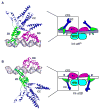The ins and outs of serine integrase site-specific recombination
- PMID: 24509164
- PMCID: PMC4267755
- DOI: 10.1016/j.sbi.2014.01.003
The ins and outs of serine integrase site-specific recombination
Abstract
Serine integrases catalyze the integration and excision of phage genomes into and out of bacterial chromosomes in a highly specific and directional manner, making these proteins powerful tools for genome engineering. In 2013, the first structure of a serine integrase-DNA complex was reported. This work revealed how the phage attP sequence is recognized by the integrase and provided important clues about how serine integrases bind to other attachment site sequences. The resulting structural models indicate that distinct spatial arrangements of integrase domains are present for each attachment site complex. Here we describe how serine integrases may exploit this site-dependent domain arrangement to regulate the direction of recombination. We also discuss how phage-encoded recombination directionality factors could change this directionality by altering the nature of inter-subunit interactions.
Copyright © 2014 Elsevier Ltd. All rights reserved.
Figures




References
-
- Groth AC, Calos MP. Phage integrases: biology and applications. J Mol Biol. 2004;335:667–78. - PubMed
-
- Smith MCM, Brown WRA, McEwan AR, Rowley PA. Site-specific recombination by phiC31 integrase and other large serine recombinases. Biochem Soc Trans. 2010;38:388–94. A recent review of serine integrases that covers mechanistic studies through 2010. - PubMed
-
- Grindley N, Whiteson K, Rice P. Mechanisms of site-specific recombination. Annu Rev Biochem. 2006;75:567–605. - PubMed
-
- Li W, Kamtekar S, Xiong Y, Sarkis GJ, Grindley NDF, Steitz TA. Structure of a synaptic gammadelta resolvase tetramer covalently linked to two cleaved DNAs. Sci 80- 2005;309:1210–5. - PubMed
Publication types
MeSH terms
Substances
Grants and funding
LinkOut - more resources
Full Text Sources
Other Literature Sources

